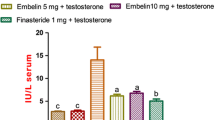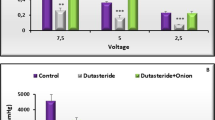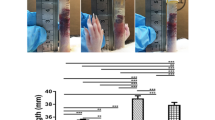Abstract
Oysters have been thought to significantly improve the male sexual function for thousands of years. To explore the effects of an enzymatic hydrolysate of oyster preparation on erectile dysfunction (ED), hemicastrated male rats were divided into control, positive control and oyster hydrolysate high dose group (0.617 g/kg body weight per day), medium dose group (0.308 g/kg) and low dose group (0.103 g/kg), respectively. After castration, the growth, development and the organ indexes of accessory sex glands and immune organs of the rats were significantly decreased than those of normal rats. Oyster hydrolysate significantly shortens the latency of penile erection induced by electrical stimulation in a dose-dependent manner, indicating that oyster hydrolysate also has significant effects on alleviating ED. Further analysis revealed that the serum levels of testosterone and luteinizing hormone and NO were significantly higher than those in the castrated model group, and were similar to those in the normal control group, indicating that oyster hydrolysate promotes the synthesis of testosterone by stimulating the synthesis of luteinizing hormone, which then increased the serum NO content through the NO-cGMP signaling pathway.

Similar content being viewed by others
References
Asha KK, Remya Kumari KR, Ashok Kumar K et al (2016) Sequence determination of an antioxidant peptide obtained by enzymatic hydrolysis of oyster Crassostrea madrasensis (Preston). Int J Pept Res Ther 22(3):421–433
Baburski AZ, Medar ML, Andric SA, Kostic TS (2017) Circadian rhythm patterns of NO-cGMP signaling are moderately synchronized by melatonin in testosterone-producing Leydig cells. Biologia Serbica 39(2):17–24
Cheraghi H, Zendehdel M, GhiasiGhalehkandi J et al (2019) The effect of leptin on sex hormones and antioxidant enzyme levels in obese and normal male rats. Int J Pept Res Ther 25(3):1105–1111
Dittrich R, Beckmann W, Oppelt P, Hoffmann I, Lotz L, Kuwert T, Mueller A (2011) Thyroid hormone receptors and reproduction. J Reprod Immunol 90(1):58–66
Ellis WJ, Grayhack JT (1963) Sexual function in aging males after orchiectomy and estrogen therapy. J Urol 89(6):895–899
Gava G, Mancini I, Cerpolini S, Baldassarre M, Seracchioli R, Meriggiola M (2018) Testosterone undecanoate and testosterone enanthate injections are both effective and safe in transmen over 5 years of administration. Clin Endocrinol 89(6):878–886
Gu L, Xiong WT, Zhuang YL, Zhang JS, Liu X (2016) Effects of Cistanche deserticola extract on penis erectile response in castrated rats. Pak J Pharm Sci 29(2):557–562
Eardley I, Donatucci C, Corbin J et al (2010) Pharmacotherapy for erectile dysfunction. J Sex Med 7(1):524–540
Li WJ, Li L, Zhen WY et al (2017) Ganoderma atrum polysaccharide ameliorates ROS generation and apoptosis in spleen and thymus of immunosuppressed mice. Food Chem Toxicol 99(1):199–208
Li CZ, Pan ZF, Chen YH, Zhang YQ, Huang XR, Huang JX (2012) Research progress in active substance of oyster softbody. Sci Technol Food Ind 33(8):412–415
Luo QJ, Lu SB, Li H, Jing Z, Xiong JY, Zhang YJ (2013) The effect of oyster peptides supplementation on serum testosterone, LH content and StAR mRNA expression in rats during the long-term and high loading training. J Jiangxi Norm Univ (Nat Sci Ed) 37(6):611–616
Malviya N, Malviya S, Jain S, Vyas S (2016) A review of the potential of medicinal plants in the management and treatment of male sexual dysfunction. Andrologia 48(9):880–893
Miao J, Liao W, Kang M et al (2018) Anti-fatigue and anti-oxidant activities of oyster (Ostrea rivularis) hydrolysate prepared by compound protease. Food Funct 9(12):6577–6585
Miner MM, Kuritzky L (2007) Erectile dysfunction: a sentinel marker for cardiovascular disease in primary care. Clev Clin J Med 74(3):S30–S37
Montorsi F, Adaikan G, Becher E et al (2010) Summary of the recommendations on sexual dysfunctions in men. J Sex Med 7(11):3572–3588
Ridzwan BH, Hanani MP, Norshuhadaa S, Hanis ZF, Aileen TSH (2013) Screening for aphrodisiac property in local oyster of Crassostrea iredalei. World Appl Sci J 26(12):1546–1551
Rosen RC, Riley A, Wagner G, Ian H, Kirkpatrick J, Mishra A (1997) The international index of erectile function (IIEF): a multidimensional scale for assessment of erectile dysfunction. Urology 49(6):822–830
Shamloul R, Ghanem H (2013) Erectile dysfunction. Lancet 381(1):153–165
Umayaparvathi S, Arumugam M, Meenakshi S, Drager G, Kirschning A, Balasubramanian T (2014) Purification and characterization of antioxidant peptides from oyster (Saccostrea cucullata) hydrolysate and the anticancer activity of hydrolysate on human colon cancer cell lines. Int J Pept Res Ther 20(2):231–243
Wagner BA, Braddick VC, Batson CG, Cullen BH, Erin Miller L, Spritzer MD (2018) Effects of testosterone dose on spatial memory among castrated adult male rats. Psychoneuroendocrinology 89(3):120–130
Wang Q, Li W, He Y et al (2014) Novel antioxidative peptides from the protein hydrolysate of oysters (Crassostrea talienwhanensis). Food Chem 145:991–996
Zhang ZR, Sun GW, Zhou FB, Lin LZ, Liu XL, Zhao MM (2019) Alcalase-hydrolyzed oyster (Crassostrea rivularis) meat enhances antioxidant and aphrodisiac activities in normal male mice. Food Res Int 120(6):178–187
Funding
The funding was provided by Marine and Fisheries Bureau of Haikou (Grant No. HHCL201804).
Author information
Authors and Affiliations
Corresponding author
Ethics declarations
Conflict of interest
The authors have no conflicts of interest to declare.
Informed Consent
This manuscript does not contain any studies with human subjects performed by any of the authors.
Research Involving Human and Animal Rights
All experiments executed according to the Guide for the Care and Use of Laboratory Animals and approved by the institutional animal ethics committee.
Additional information
Publisher's Note
Springer Nature remains neutral with regard to jurisdictional claims in published maps and institutional affiliations.
Rights and permissions
About this article
Cite this article
Wang, HY., Yan, Z., Liu, S. et al. Effects of Enzymatic Hydrolysate of Oyster on Erectile Function in Male Hemicastrated Rats. Int J Pept Res Ther 26, 2001–2007 (2020). https://doi.org/10.1007/s10989-019-09989-y
Accepted:
Published:
Issue Date:
DOI: https://doi.org/10.1007/s10989-019-09989-y




